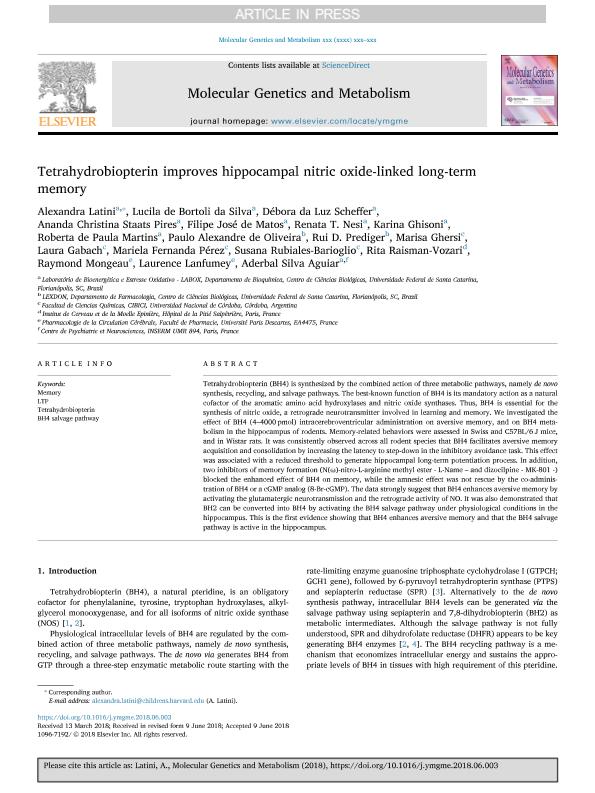Artículo
Tetrahydrobiopterin improves hippocampal nitric oxide-linked long-term memory
Latini, Alexandra; de Bortoli da Silva, Lucila; da Luz Scheffer, Débora; Pires, Ananda Christina Staats; de Matos, Filipe José; Nesi, Renata T.; Ghisoni, Karina; de Paula Martins, Roberta; de Oliveira, Paulo Alexandre; Prediger, Rui D.; Ghersi, Marisa Soledad ; Gabach, Laura
; Gabach, Laura ; Perez, Mariela Fernanda
; Perez, Mariela Fernanda ; Rubiales, Susana Elizabeth
; Rubiales, Susana Elizabeth ; Raisman-Vozari, Rita; Mongeau, Raymond; Lanfumey, Laurence; Aguiar, Aderbal Silva
; Raisman-Vozari, Rita; Mongeau, Raymond; Lanfumey, Laurence; Aguiar, Aderbal Silva
 ; Gabach, Laura
; Gabach, Laura ; Perez, Mariela Fernanda
; Perez, Mariela Fernanda ; Rubiales, Susana Elizabeth
; Rubiales, Susana Elizabeth ; Raisman-Vozari, Rita; Mongeau, Raymond; Lanfumey, Laurence; Aguiar, Aderbal Silva
; Raisman-Vozari, Rita; Mongeau, Raymond; Lanfumey, Laurence; Aguiar, Aderbal Silva
Fecha de publicación:
09/2018
Editorial:
Academic Press Inc Elsevier Science
Revista:
Molecular Genetics And Metabolism
ISSN:
1096-7192
Idioma:
Inglés
Tipo de recurso:
Artículo publicado
Clasificación temática:
Resumen
Tetrahydrobiopterin (BH4) is synthesized by the combined action of three metabolic pathways, namely de novo synthesis, recycling, and salvage pathways. The best-known function of BH4 is its mandatory action as a natural cofactor of the aromatic amino acid hydroxylases and nitric oxide synthases. Thus, BH4 is essential for the synthesis of nitric oxide, a retrograde neurotransmitter involved in learning and memory. We investigated the effect of BH4 (4–4000 pmol) intracerebroventricular administration on aversive memory, and on BH4 metabolism in the hippocampus of rodents. Memory-related behaviors were assessed in Swiss and C57BL/6 J mice, and in Wistar rats. It was consistently observed across all rodent species that BH4 facilitates aversive memory acquisition and consolidation by increasing the latency to step-down in the inhibitory avoidance task. This effect was associated with a reduced threshold to generate hippocampal long-term potentiation process. In addition, two inhibitors of memory formation (N(ω)-nitro-L-arginine methyl ester - L-Name – and dizocilpine - MK-801 -) blocked the enhanced effect of BH4 on memory, while the amnesic effect was not rescue by the co-administration of BH4 or a cGMP analog (8-Br-cGMP). The data strongly suggest that BH4 enhances aversive memory by activating the glutamatergic neurotransmission and the retrograde activity of NO. It was also demonstrated that BH2 can be converted into BH4 by activating the BH4 salvage pathway under physiological conditions in the hippocampus. This is the first evidence showing that BH4 enhances aversive memory and that the BH4 salvage pathway is active in the hippocampus.
Palabras clave:
BH4 SALVAGE PATHWAY
,
LTP
,
MEMORY
,
TETRAHYDROBIOPTERIN
Archivos asociados
Licencia
Identificadores
Colecciones
Articulos(CIBICI)
Articulos de CENTRO DE INV.EN BIOQUI.CLINICA E INMUNOLOGIA
Articulos de CENTRO DE INV.EN BIOQUI.CLINICA E INMUNOLOGIA
Articulos(IFEC)
Articulos de INST. DE FARMACOLOGIA EXPERIMENTAL DE CORDOBA
Articulos de INST. DE FARMACOLOGIA EXPERIMENTAL DE CORDOBA
Citación
Latini, Alexandra; de Bortoli da Silva, Lucila; da Luz Scheffer, Débora; Pires, Ananda Christina Staats; de Matos, Filipe José; et al.; Tetrahydrobiopterin improves hippocampal nitric oxide-linked long-term memory; Academic Press Inc Elsevier Science; Molecular Genetics And Metabolism; 125; 1-2; 9-2018; 104-111
Compartir
Altmétricas



